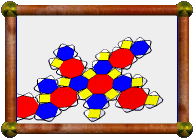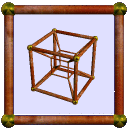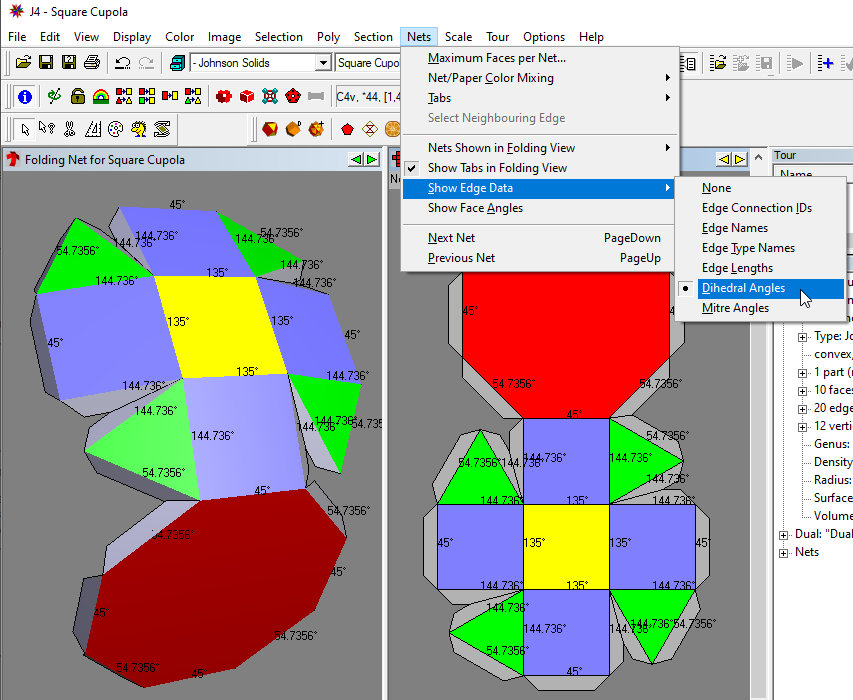


Stella FAQ (Frequently Asked Questions) |
Contents
- General questions
- Q. Can I try before I buy?
- Q. How do I buy it?
- Q. Can I pay by card? I don't have a PayPal account.
- Q. Can I add a link to your web site?
- Q. Does Stella4D only include 4D stuff?
- Q. What's the difference between Small Stella and Great Stella?
- Q. What's the difference between Great Stella and its demo version?
- Q. What platforms does it run on?
- Q. Can I run it on a Mac?
- Q. Can you send me unfolded nets to print?
- Installation problems
- Questions about using the program
- Q. Are tabs printed on nets?
- Q. Where can I see the dihedral angles?
- Q. Can I use a 3D printer to print models from Stella?
- Q. Why can't I see the great dodecahedron in the base+dual compound view?
- Q. Why do some dual models look the same? Is it a bug?
- Q. When I use "Stellation->Enumerate" with the icosahedron, shouldn't I get 59 of them?
- Q. When I use "Stellation->Enumerate", why does the time remaining always get bigger?
- IAQ (Infrequently Asked Questions)
General questions
A: Yes, there's a limited demo version here.
A: Go here.
Q: Can I pay by card? I don't have a PayPal account.
A: Yes. Start your purchase here. When you get to the page shown below, click "Pay with a Card", circled below. This will still be processed by PayPal behind the scenes, but you don't need to create an account.
Q: Can I add a link to your web site?
A: YES! Please do! If possible, please include the word "polyhedron" in the text of the link, e.g. Stella: Polyhedron Navigator. This helps Google's search engine to know what my site is about. You might even want to put the Stella logo beside it:![]()
Q: Does Stella4D only include 4D stuff?
A: No, it also includes all the 3D features from . If you have Stella4D, you don't need Great Stella.
Q: What's the difference between Small Stella and Great Stella?
A: has all the uniform polyhedra built in (not just the Platonics, Archimedeans, Kepler-Poinsot and convex prisms). It also has pyramids, cupolae, cuploids, and cupolaic-blends built-in. It has advanced features for creating new models too, including stellation, faceting, augmentation/excavation/drilling, finding convex hulls etc, and it can export models to various 3D formats. See the comparison chart.
Q: What's the difference between Great Stella and its demo version?
A: The demo is limited in many ways. It only has a limited set of built-in models (the other ones remain in the list but are greyed out, so you can see what you're missing). It only allows features such as stellation, faceting, and augmentation/excavation/drilling to be applied to an even more limited set of models.
Also, the demo version can only export the cube to the various 3D formats, and will only allow printing for the Platonic solids. For example you can print nets for the dodecahedron. Print preview is available for any model though, so you can see what the print-outs would look like (which is often a bit different from what's normally on the screen).
Q: What platforms does it run on?
A: Windows 95, 98, ME, NT4, 2000, XP, Vista, Windows 7, Windows 8, Windows 10. You should set your display for at least 16-bit colour. You can still run it on an 8-bit colour display, but you will get screwy colours, and even the toolbars use 24-bit colour images.
A: Not directly. You would need a way to run Windows programs on your Mac. Here are some possibilities:
- Install Windows as a separate boot option, using Boot Camp which comes with all new Macs, but you still need a copy of Windows to install. This option is likely to work best, but means you can't switch back to the Mac environment without rebooting.
- Install Windows under a PC emulator, like Virtual PC or the newer Parallels. Again, you'll need a working copy of Microsoft Windows to install. One person reported problems with Parallels and Windows 7. This was OpenGL-related, and they got it working after finding a forum post which "recommended adding vertical synchronization and maximizing display memory". So if you have trouble, maybe that will help.
- Try CrossOver which lets you run Windows programs directly. No need to install Windows. I've been told this mostly works, but exporting images/videos fails. UPDATE: A couple of people lately have reported that CrossOver doesn't work for them, so possibly the newer versions of CrossOver don't support Stella.
And of course, try the free demo version first to confirm it works.
Q: Can you send me unfolded nets to print?
A: I don't generally do this. I've spent hundreds, probably thousands, of hours working on Stella, which I sell. The idea is that people can buy the software and print their own nets, for whatever models they want, at whatever size they want. I'd be selling myself short if I gave them away for free.
I've thought about selling nets for individual shapes, for say US$10 each, but nothing's in place so far. Let me know if this might be of interest to you.
Installation problems
Q: I need to re-enter my serial number every time.
A: Some people have reported this. Try running it once as admin and enter the serial number. Hopefully after that it will run without asking for the serial number again, regardless of whether or not it's run as admin.
Q: (Usually on a laptop) Why are my windows all white? Or why does it crash as soon as I run it?
A: Some graphics cards seem to have a problem where some windows get drawn as solid white, either always, or after changing the view layout one or more times. Some graphics cards can even cause the program to crash straight away! These problems are more likely to happen on laptops. The Savage S3 graphics card has caused both these problems. For that card, right-click on the desktop and select Properties from the menu to open the display properties. Select the Performance tab. A slider lets you turn hardware performance up or down. Turn it down to a lower level. The description for the level you want might say something like this: "Basic acceleration functions: Use this setting to correct more severe problems, such as unexpected errors in programs.". (Yes, it actually says that!).
Questions about using the program
A: As of version 5.0, yes!
Q: Where can I see the dihedral angles?
A: Dihedral angles can be displayed in the Unfolded Net View and the Folding Net View via the menu using "Nets->Show Edge Data->Dihedral Angles"
Q: Can I use a 3D printer to print models from Stella?
A: Yes. Great Stella and Stella4D can export models as STL format, which is for 3D printing, or you may have success with one of the other export formats. Generally you should select the Stellation View before exporting. This will export a model consisting of just the externally visible surfaces, which will work better for 3D printing. The normal Base Polyhedron View could export a set of intersecting faces, which may cause problems.
You may also want to experiment with exporting the edges as cylinders and the vertices as spheres. You can then hide all the faces to export a hollow skeleton model.
Q: Why can't I see the great dodecahedron in the base+dual compound view?
A: The great dodecahedron is hidden entirely within the small stellated dodecahedron. This is correct. The dual is made by spherical reciprocation about the mid-sphere (the sphere touching the mid-points of each edge of the uniform polyhedron). I won't explain these terms here, but this method leads to the great dodecahedron being entirely hidden with the small stellated dodecahedron.
Q: Why do some dual models look the same? Is it a bug?
A: It's not a bug, some duals of different uniform polyhedra do in fact look exactly the same. Their faces only differ inside the model where you can't see it. One way to see the difference is to select a face, which makes it highlight in white and show partly transparently through the other faces. Then you can see the difference. Also if you explode the faces apart (Ctrl + Shift + left mouse drag) you can see that they are different shapes.
Q: When I use "Stellation->Enumerate" with the icosahedron, shouldn't I get 59 of them?
A: It depends what criteria are used for accepting a valid stellation. The Fifty-nine Icosahedra uses Miller's Rules, but the default is set to Fully Supported. To see which criteria are available and change to a different one, have a look at "Stellation->Stellation Criteria". Changing the selection here will affect how many stellations are found when you enumerate, and affects which stellations you see when using the Up and Down arrows.
Q: When I use "Stellation->Enumerate", why does the time remaining always get bigger?
A: To figure out how long there is to go, it needs to guess about how far through the enumeration it is. Of course, if it knew exactly how far through it was, then it would already know the answer! It is very difficult to guess how far through you are. The time remaining increases as it gets a better idea about how many stellations are left to count. Depending on the model and the stellation criteria chosen, it may take a second, or a day, or a thousand years or more to come up with an answer!
The estimate is currently not very good for Fully Supported stellations, but it is much better for Miller's Rules. You can select this criteria using "Stellation->Stellation Criteria". Now when you enumerate, many models will tell you how many millions of years remain!
IAQ (Infrequently Asked Questions)
If you have a question that isn't answered above, then you can ask on the forums or send me a message. For general questions about what stellation means and other polyhedral matters, you will find a lot of information just by searching the internet, or see my paper Stella: Polyhedron Navigator which covers a lot of the techniques available.